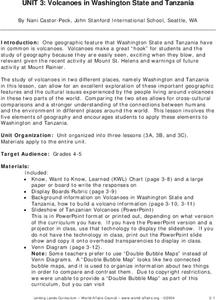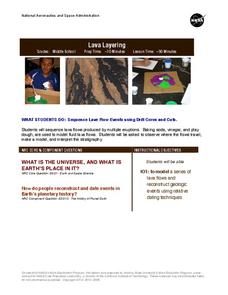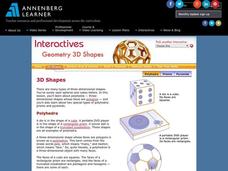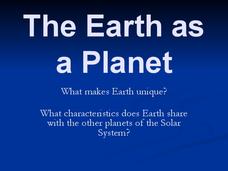Curated OER
Are We Falling Apart? Exploding Volcanoes
Young scholars explore how volcanoes are formed, list the parts and characteristics of volcanoes, state the differences in various types of lava, and analyze the volume of ejecta from a volcano.
Curated OER
A Model of a Strato Volcano
Students build a volcano model on tag board. They add lava and ash layers simulating the process that builds a real strato volcano cone.
Curated OER
Volcano
Middle schoolers research major volcanic eruptions. In this Earth science lesson, students take on the role of vulcanologist writing reports to the President of the United States on how to respond to a volcanic disaster. This lesson...
Curated OER
Mini-Volcanoes!
Students define volcanoes and why they erupt. Using baking soda, vinegar, and soap detergent, students create and observe their own volcanoes erupting. A brain-pop video can be used to follow-up the activity (found on website).
Curated OER
Formation of Volcanoes
Ninth graders explore the process of different volcanoes and how plate tectonics plays a role. In this volcanic instructional activity students complete several assignments on plate tectonics.
Curated OER
The Effects of Volcanoes
Students use the internet to research the effects of volcanoes. They create a chart showing the negative and positive aspects that a volcanoe can bring to an area. Using PowerPoint, they create a presentation showing the negative and...
Curated OER
Peanut Brittle Volcano
Pupils see simulated lava flow down a simulated volcano. They examine how lava cools fastest on the surface.
Curated OER
Natural Disasters: An Adventure in Non-Fiction
Students study different natural disasters. In this natural disaster lesson students read a nonfiction book followed by a discussion, an experiment, then collect illustrations from their experience.
Curated OER
Melted Minerals
Students study the elements of an active volcano. They identify the underground components of this geological occurrence. Students construct and label a three-dimensional model to represent their findings. They are told that volcanic...
Curated OER
Volcanoes
Students investigate types of volcanoes. In this earth science lesson, students view a diagram of a volcano on an overhead projector and discuss the types of volcanoes. Students choose a volcano and write five facts about it.
Curated OER
Eyewitness Accounts
Students role-play to show the eyewitness accounts of the eruption of Mt. St. Helens. In this volcanic eruption lesson, students act as reporters, eyewitnesses, and scientists to dramatize the eruption of Mt. St. Helens. They discuss the...
Curated OER
Happy Lesson: The Earth's Crust
This PowerPoint provides a multiple choice and fill-in-the-blank format for reviewing vocabulary and related content following an "earth's crust" science unit. The information is concise and age-appropriate and the font and colors are...
Curated OER
Volcanoes: Mount Vesuvius
Students explain how volcanoes form. In this earth science lesson, students identify the different types of volcanoes. They create brochures about Mt. Vesuvius before and after the eruption.
Curated OER
Volcanoes in Washington State and Tanzania
Young scholars research volcanoes in Washington State and in Tanzania and create a poster on one specific volcano in each area. Once research is complete on each area, students compare and contrast volcanoes in Washington State and...
Curated OER
Volcano Research Project
Students research a volcano that has erupted in the last 100 years. In this earth science lesson, students explain the effect of the eruption to the population. They communicate what they would do to minimize the effect of this disaster.
Curated OER
Science: Plate Tectonics, Faults, and Volcanoes
Eighth graders conduct Internet research on plate tectonics, faluts, and volcanoes. In groups, they compile information related to teacher-provided questions. Students write papers detailing their findings and make oral presentations...
NOAA
A Quest for Anomalies
Sometimes scientists learn more from unexpected findings than from routine analysis! Junior oceanographers dive deep to explore hydrothermal vent communities in the fourth lesson in a series of five. Scholars examine data and look for...
NASA
Lava Layering
Take the old baking soda and vinegar volcano to the next level by using it to study repeated lava flows over time, examine geologic features on Earth and Mars, and speculate about some of the formations on Mars.
NOAA
Exploring Potential Human Impacts
Arctic sea ice reflects 80 percent of sunlight, striking it back into space; with sea ice melting, the world's oceans become warmer, which furthers global warming. These activities explore how humans are impacting ecosystems around the...
Annenberg Foundation
Geometry 3D Shapes: 3D Shapes
Explore vocabulary related to three-dimensional shapes. An instructional website describes the characteristics of different geometric solids. Learners can use an interactive component to view nets, faces, vertices, and edges of common...
Intel
Lights, Camera, Reaction!
Excite classes with a STEM project-based learning lesson covering chemical reactions. Groups study the different types through simulations and hands-on activities. They pick one type (synthesis, decomposition, single displacement, double...
Glynn County School System
The Earth as a Planet
What does our planet have in common with other planets? What makes it unique? Find out in a PowerPoint presentation highlighting many earthly facts! The lesson describes Earth's atmosphere in detail and adds many other important facts...
CK-12 Foundation
Topographic and Geologic Maps: Topographic Maps
Maps are great for helping you get where you're going, but what does that place actually look like? Geology scholars compare and contrast the features of topographical and geologic maps using an interactive lesson. The resource describes...
Curated OER
Igneous Rocks
Second graders examine igneous rocks in this lesson. They discuss the rock cycle and how rocks form. They also explore volcanic activities and build their own volcano.

























